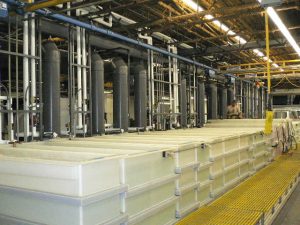Kinds of Phosphate Treatment for Powder Coating

Kinds of Phosphate treatment for powder coating
Iron phosphate
Treatment with iron phosphate (often called thin layer phosphating) provides very good adhesion properties and has no adverse effects in the mechanical properties of the powder coating. Iron phosphate provides good corrosion protection for exposure in the low and middle corrosion classes, though it cannot compete with zinc phosphate in this respect. Iron phosphate can be used in either spray or dip facilities. The number of steps in the process may vary from 2-7, depending on the basemetal and the requirement for protection. In relation to zinc phosphate treatment, the iron phosphate process is generally cheaper and simpler to accomplish The phosphate layer normally weighs between 0.3-1.0g/m2.
Zinc phosphate
The zinc phosphate process deposits a thicker layer than iron phosphating, and is securely anchored to the base material. Zinc phosphate also has very favourable adhesion properties, though in some cases it may reduce the mechanical integrity (flexibility of the system. Zinc phosphate provides excellent corrosion protection and is recommended for pre-treatment of steel and galvanized steel for exposure in high corrosion classes. Zinc phosphate can be used in either spray or dip facilities. The number of steps in the process varies between 4-8.
Zinc phosphating is normally more expensive than iron phosphating, due to both higher plant costs and more expensive operation.
Chromate
A series of different systems are available within the chromate group of treatments. The system selected depends on the type of metal or alloy, the type of object (method of manufacture: casr, extruded etc.) and of course, quality requirements.
Chromate treatment may be sub-divided into:
- Thin layer chromate treatment
- Green chromate treatment
- Yellow chromate trearment
The latter is the most common method for pre-treatment prior to powder coating. The number of steps in the process may vary, depending on how extensively the goods have to be prepared for chromating, for example by pickling, neutralization etc. and consequent rinsing steps.

Comments are Closed